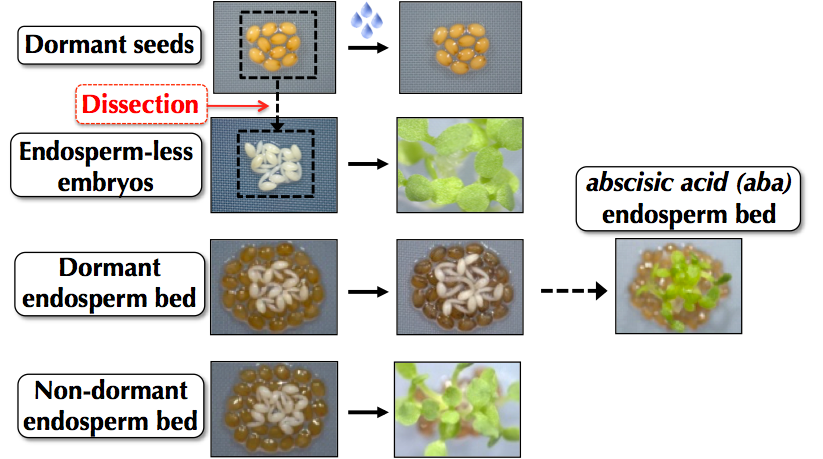Research




Seed Coat Bedding Assay (SCBA)

Germination is the first visible step of the profound developmental transformation taking the quiescent and highly protected plant embryo within the dry seed towards a young and highly fragile seedling. Control mechanisms can interrupt germination in response to abiotic parameters (e.g. light quality, osmotic potential, temperature) potentially harmful to the seedling.
For many years, our laboratory has studied the different molecular genetic mechanisms underlying this control and this subject remains a long-term interest.
For many years, our laboratory has studied the different molecular genetic mechanisms underlying this control and this subject remains a long-term interest.
Control of seed germination is orchestrated by the phytohormones gibberellic acid (GA) and abscisic acid (ABA) whose endogenous levels are regulated by the environment. GA promotes germination by promoting the destruction of DELLA factors, notably RGL2, GAI and RGA, acting as germination repressors (Lee et al 2000, Piskurewicz et al 2009). ABA represses seed germination. This involves notably the de novo production of the ABA-response leucine-zipper transcription factor ABI5, which represses seed germination and directly stimulates the transcription of Late Embryonic Abundant (LEA) genes (Finkelstein and Lynch, 2000; Lopez-Molina and Chua 2000). This mechanism maintains the plant in its embryonic protected state (Lopez-Molina et al. 2001, 2002).
We are interested in understanding how the production of GA and ABA by seeds is controlled in response to environmental cues. Indeed, GA and ABA exert antagonistic effects on seed germination. Therefore, their production by seeds must be coordinated in response to environmental cues. This question has been addressed in a number of publications and continues to be studied in the laboratory. So far, the general conclusion is that environmental conditions unfavorable for seed germination, such as presence of canopy light, repress endogenous GA synthesis, which leads to accumulation of DELLA factors. In turn, DELLA factors promote endogenous ABA synthesis in an unknown manner (Piskurewicz et al 2008, 2009, Lee et al. 2010). Finally, elevation of endogenous ABA levels prevents seeds germination by stimulating the expression of ABA-response transcription factors that repress germination (e.g. ABI3 and ABI5).


However, an additional level of complexity is brought by the endosperm, a single cell layer surrounding the embryo. The endosperm plays a central role for the control of seed germination by producing and releasing ABA towards the embryo to block its growth (Lee et al 2010). The laboratory is interested in understanding the biological role of the endosperm in seeds. For this purpose, we have developed the “seed coat bedding assay” (SCBA) (Lee et al 2010). The SCBA is an in vitro technique where the dissected Arabidopsis embryo is cultured on a layer of dissected endosperms (with the testa still attached). This allows to study the influence of the endosperm on the growth and development of the embryo, allowing combinatorial use of mutant embryos and endosperm.

The SCBA was used to show that the endosperm of dormant seeds produces and releases ABA towards the embryo, unlike the endosperm of non-dormant seeds (Lee et al 2010).

The light receptors phytochrome B (phyB) and phyA play a central and complex role to control seed germination in response to light cues. The SCBA was also used to show that phyB primarily signals in the endosperm whereas phyA signals in the embryo (Lee et al. 2012).
In collaboration with the group of Profs Youngsook Lee (Postech, Korea) and Enrico Martinoia (University of Zurich, Switzerland), we used the SCBA to identify ABA transporters delivering ABA from the endosperm to the embryo (Kang et al 2015).

Further reading:
Abscisic acid transporters cooperate to control seed germination.
Kang J, Yim S, Choi H, Kim A, Lee KP, Lopez-Molina L, Martinoia E, Lee Y.
Nat Commun. 2015 Sep 3;6:8113. doi: 10.1038.
Spatially and genetically distinct control of seed germination by phytochromes A and B.
Lee KP, Piskurewicz U, Turecková V, Carat S, Chappuis R, Strnad M, Fankhauser C, Lopez-Molina L.
Genes Dev. 2012 Sep 1;26(17):1984-96.
Lee KP, Piskurewicz U, Turečková V, Strnad M and Lopez-Molina L.
PNAS 2010 Nov 2; 107(44):19108-13.
Piskurewicz U, Jikumaru Y, Kinoshita N, Nambara E, Kamiya Y, Lopez-Molina L.
Plant Cell 2008 20: 2729-2745.
Piskurewicz U, Turecková V, Lacombe E, Lopez-Molina L.
EMBO J. 2009 Aug 5;28(15):2259-71.
University of Geneva • Department of Plant Biology • 30 Quai Ernest-Ansermet • 1211 Geneva Switzerland